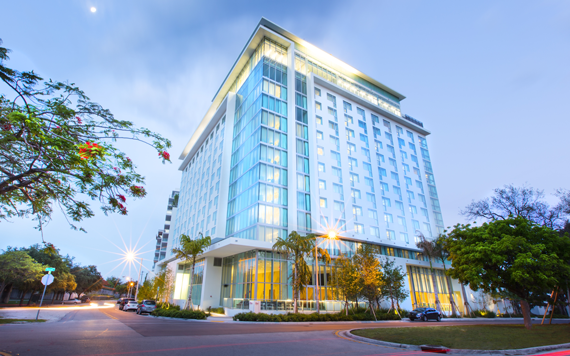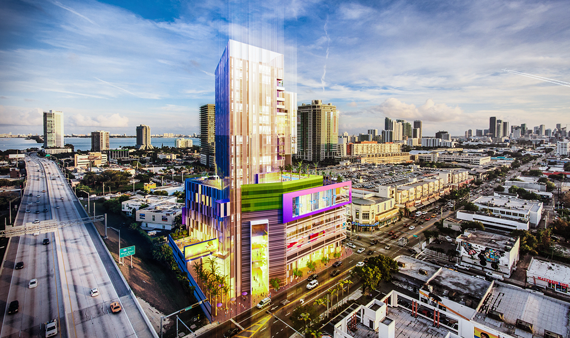Swank new hotels are rising up in the Magic City, thanks to the money that developers from far and wide have poured into boutique projects and grand high-rises alike.
With thousands of new rooms slated to hit the Miami market over the next two years, observers have been increasingly vocal in their worries about oversupply.
“It’s one of the markets we’re concerned about, certainly in terms of relative performance,” said Stephen Boyd, a senior director in the real estate division of Fitch Ratings.
Some 9,132 new keys are planned for Miami, according to an analysis done by The Real Deal in September that included planned and proposed projects, as well as hotels that were under construction. The largest of these projects, the Marriott Marquis planned as part of the Miami Worldcenter development in downtown Miami, would add a whopping 1,800 rooms.
 Miami’s hotel supply was up 3.9 percent during the first half of 2016, according to Boyd, much higher than the national average of 1.5 percent. Along with other analysts — as well as investors — he wonders if there’s enough demand to meet the expansion. He pointed with concern to the situation in Brazil — consistently the top source of foreign tourists, according to the Greater Miami Convention and Visitors Bureau — which is mired in a deep recession. And he noted that the spread of the Zika virus into Miami could potentially put a dent in tourism.
Miami’s hotel supply was up 3.9 percent during the first half of 2016, according to Boyd, much higher than the national average of 1.5 percent. Along with other analysts — as well as investors — he wonders if there’s enough demand to meet the expansion. He pointed with concern to the situation in Brazil — consistently the top source of foreign tourists, according to the Greater Miami Convention and Visitors Bureau — which is mired in a deep recession. And he noted that the spread of the Zika virus into Miami could potentially put a dent in tourism.

CEO Francisco Levine
Some figures already suggest a softening market. Through the first seven months of 2016, Miami hotels saw a 3.2 percent dip in revenue per available room, a key industry indicator. The occupancy rate also dipped, though only slightly, to 79.4 percent from 80.3 percent a year earlier, according to the lodging industry analytics company STR.
But for the time being, demand remains relatively robust. Through July, the number of room nights selling in Miami rose 2.8 percent from the previous year, to reach nearly 8.9 million. Even in July, Miami’s off-season, the average room rate was $158, compared with a national average of $129.
Developers are focusing on the nearly 80 percent occupancy rates, compared with 63 percent nationwide. “The high occupancy overall seems to point to the fact that there is unaccounted-for demand,” said Jan Freitag, an STR analyst and senior vice president. “Developers are voting with their wallets.”
Slim margin of error, tough terms
While it is true that developers — particularly those with shovels in the ground — continue to tout the area’s positive hospitality stats, at this point in the cycle, they are drilling down into the numbers, looking at soaring land and construction costs, and wondering if it still makes sense to build.
“Projects are becoming a lot harder to justify economically, and the margin of error on these projects has come down significantly,” said Boaz Ashbel, a managing director at Aztec Group, a Miami-based firm that invests in hotel projects and also serves as a broker connecting debt providers with developers.
He estimated that the cost per square foot for construction alone has reached $100 to $110 a square foot for a mid-rise building of up to eight stories, up from $70 to $75 five years ago.

A rendering of the 275-room Atton Brickell Miami.
Ashbel said that some lenders have become inactive in the Miami hotel space, while others have decided to work only with existing clients. He said those banks and other financiers that are still investing in local hotel projects have toughened their terms, with interest rates for hotel loans rising by 1.5 to 2 points over the past 18 to 24 months.
And given this late stage in the cycle, hotel developers are becoming pickier about where they choose to build, and how much they are willing to fork over for land.
“We’ve tried to be very careful on the location of our projects,” said Jose Herrera, general manager of HES Group, a Venezuelan development company that opened a Miami office in 2011. “We don’t have anything on the beach, which is very competitive. We are trying to look at those specific locations where you still have a growing level of supply and not enough rooms.”
Herrera said that Coral Gables was a “perfect example” of what his company was looking for now. HES is building a 137-room Aloft hotel in Coral Gables, as well as the 140-room Hotel Indigo in Brickell. Both hotels are slated for 2017.
Atton Hotels, a Chilean hospitality company, was also very specific in its desired location. The company made its U.S. debut in July with the opening of the 275-room Atton Brickell. “We felt very strongly about the opportunity of putting a flagship for Atton in the Brickell area,” Levine told The Real Deal.
Herrera said he also sees growth potential in the Design District in Downtown Miami, where HES is building the 296-room Triptych, which will be part of the Hilton Curio Collection.
“We still believe in Miami,” Herrera said. “Even though there is a lot of supply coming in, the demand for hotels in Miami has never stopped growing.”
